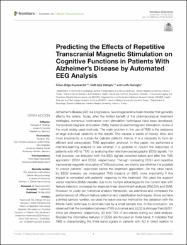| dc.contributor.author | Kayasandık, Cihan Bilge | |
| dc.contributor.author | Velioğlu, Halil Aziz | |
| dc.contributor.author | Hanoğlu, Lütfü | |
| dc.date.accessioned | 2022-06-16T08:23:20Z | |
| dc.date.available | 2022-06-16T08:23:20Z | |
| dc.date.issued | 2022 | en_US |
| dc.identifier.citation | Kayasandık, C. B., Velioğlu, H. A. ve Hanoğlu, L. (2022). Predicting the effects of repetitive transcranial magnetic stimulation on cognitive functions in patients with alzheimer's disease by automated EEG analysis. Frontiers in Cellular Neuroscience, 16. https://doi.org/10.3389/fncel.2022.845832 | en_US |
| dc.identifier.issn | 1662-5102 | |
| dc.identifier.uri | https://doi.org/10.3389/fncel.2022.845832 | |
| dc.identifier.uri | https://hdl.handle.net/20.500.12511/9524 | |
| dc.description.abstract | Alzheimer's disease (AD) is a progressive, neurodegenerative brain disorder that generally affects the elderly. Today, after the limited benefit of the pharmacological treatment strategies, numerous noninvasive brain stimulation techniques have been developed. Transcranial magnetic stimulation (TMS), based on electromagnetic stimulation, is one of the most widely used methods. The main problem in the use of TMS is the existence of large individual variability in the results. This causes a waste of money, time, and more importantly, a burden for delicate patients. Hence, it is a necessity to form an efficient and personalized TMS application protocol. In this paper, we performed a machine-learning analysis to see whether it is possible to predict the responses of patients with AD to TMS by analyzing their electroencephalography (EEG) signals. For that purpose, we analyzed both the EEG signals collected before and after the TMS application (EEG1 and EEG2, respectively). Through correlating EEG1 and repetitive transcranial magnetic stimulation (rTMS) outcomes, we tried to see whether it is possible to predict patients' responses before the treatment application. On the other hand, by EEG2 analysis, we investigated TMS impacts on EEG, more importantly if this impact is correlated with patients' response to the treatment. We used the support vector machine (SVM) classifier due to its multiple advantages for the current task with feature selection processes by stepwise linear discriminant analysis (SWLDA) and SVM. However, to justify our numerical analysis framework, we examined and compared the performances of different feature selection and classification techniques. Since we have a limited sample number, we used the leave-one-out method for the validation with the Monte Carlo technique to eliminate bias by a small sample size. In the conclusion, we observed that the correlation between rTMS outcomes and EEG2 is stronger than EEG1, since we observed, respectively, 93 and 79% of accuracies during our data analysis. Besides the informative features of EEG2 are focused on theta band, it indicates that TMS is characterizing the theta band signals in patients with AD in direct relation to patients' response to rTMS. This shows that it is more possible to determine patients' benefit from the TMS at the early stages of the treatment, which would increase the efficiency of rTMS applications in patients with Alzheimer's disease. | en_US |
| dc.language.iso | eng | en_US |
| dc.publisher | Frontiers Media SA | en_US |
| dc.rights | info:eu-repo/semantics/openAccess | en_US |
| dc.rights | Attribution 4.0 International | * |
| dc.rights.uri | https://creativecommons.org/licenses/by/4.0/ | * |
| dc.subject | Alzheimer’s Disease | en_US |
| dc.subject | Machine Learning | en_US |
| dc.subject | Support Vector Machine | en_US |
| dc.subject | Repetitive Transcranial Magnetic Stimulation (rTMS) | en_US |
| dc.subject | Personalized Treatment | en_US |
| dc.subject | Artificial Neural Network | en_US |
| dc.title | Predicting the effects of repetitive transcranial magnetic stimulation on cognitive functions in patients with alzheimer's disease by automated EEG analysis | en_US |
| dc.type | article | en_US |
| dc.relation.ispartof | Frontiers in Cellular Neuroscience | en_US |
| dc.department | İstanbul Medipol Üniversitesi, Mühendislik ve Doğa Bilimleri Fakültesi, Bilgisayar Mühendisliği Bölümü | en_US |
| dc.department | İstanbul Medipol Üniversitesi, Rektörlük, Sağlık Bilim ve Teknolojileri Araştırma Enstitüsü | en_US |
| dc.department | İstanbul Medipol Üniversitesi, Rektörlük, Rejeneratif ve Restoratif Tıp Araştırmaları Merkezi (REMER) | en_US |
| dc.department | İstanbul Medipol Üniversitesi, Tıp Fakültesi, Dahili Tıp Bilimleri Bölümü, Nöroloji Ana Bilim Dalı | en_US |
| dc.authorid | 0000-0002-2306-5937 | en_US |
| dc.authorid | 0000-0003-4292-5717 | en_US |
| dc.identifier.volume | 16 | en_US |
| dc.relation.publicationcategory | Makale - Uluslararası Hakemli Dergi - Kurum Öğretim Elemanı | en_US |
| dc.identifier.doi | 10.3389/fncel.2022.845832 | en_US |
| dc.institutionauthor | Kayasandık, Cihan Bilge | |
| dc.institutionauthor | Velioğlu, Halil Aziz | |
| dc.institutionauthor | Hanoğlu, Lütfü | |
| dc.identifier.wosquality | Q1 | en_US |
| dc.identifier.wos | 000805486900001 | en_US |
| dc.identifier.scopus | 2-s2.0-85131674562 | en_US |
| dc.identifier.pmid | 35663423 | en_US |
| dc.identifier.scopusquality | Q1 | en_US |



















